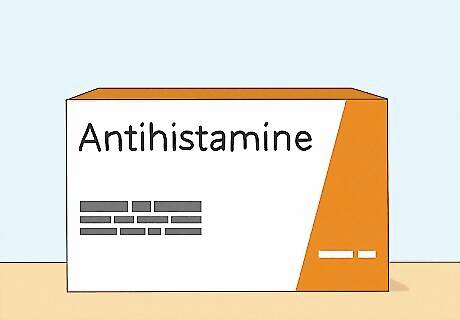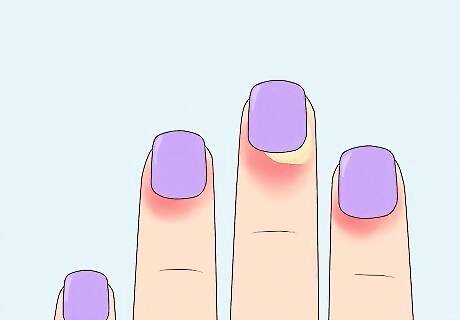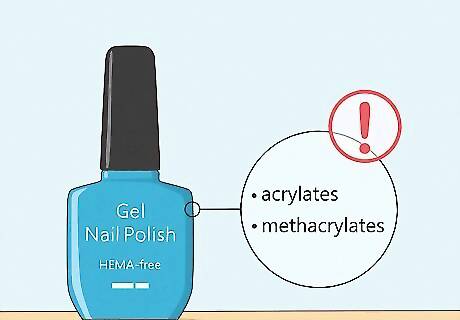
views
- Remove nail polish and take over-the-counter allergy medication to reduce swelling and irritation caused by an allergic reaction to gel nail polish.
- Gel-X and similar gel products contain acrylates. These harsh chemicals are common allergens.
- To prevent an allergic reaction, replace your gel nail products with HEMA-free or water-based nail polishes.
How to Treat an Allergic Reaction to Gel Nail Polish

Remove any polish from your nails as soon as possible. As soon as you notice any redness, itchiness, or swelling around your nail plate, remove any gel products with acetone nail polish remover. This will help limit exposure to allergens and prevent symptoms from worsening. Symptoms should alleviate within the first week. However, if discomfort persists, treatment from a licensed medical professional. If you have gel artificial nails, try wrapping your nails in plastic food wrap instead of foil to remove them. This prevents the allergen from irritating your skin. Wash your hands with warm water and fragrance-free hand soap once the polish is off. Apply a sensitive skin moisturizer to soothe your skin. If your nails are too sensitive due to swelling, itchy, or peeling skin, seek treatment from a dermatologist.

Use over-the-counter allergy medicine to soothe most symptoms. An allergic reaction to nail polish is called contact dermatitis, caused by the chemicals in polishes, fragrances, or creams. For mild symptoms, like contact dermatitis, use anti-itch creams and topical or oral antihistamines. For severe symptoms, such as unrelenting discomfort and extreme swelling or pus, contact your primary care doctor for topical or oral steroids. There are two types of contact dermatitis (CD): irritant and allergic, where the allergic CD is a delayed reaction to chemicals. Both, however, appear as a rash that can spread to other body parts. For instance, after painting your nails, you may spread CD to your eyes if you scratch an itch around them, causing them to swell and itch.

Speak to a dermatologist or allergist if symptoms persist for over a week. Minor allergic reactions usually resolve with over-the-counter medications in a few days' time. However, if pain persists or symptoms worsen for several weeks, it's important to see a doctor. A medical professional may prescribe topical or oral steroids to help you find relief, especially if discomfort persists for more than 1 to 2 weeks. If a severe allergic reaction is left untreated, it may lead to anaphylaxis, which can result in loss of consciousness or cause you to go into cardiac arrest.
Gel Nail Polish Allergy Symptoms

Itchy, swelling, and redness Typically, itchy cuticles is a result of a nail infection called paronychia, which is caused by irritants and allergens. Along with redness and swelling, pus may build up where the skin meets the nail. It can also make the sides of the nails itchy. When left untreated, your nails can grow incorrectly with ridges or waves. They may also show signs of discoloration.

Peeling skin A common experience people share on social media platforms like TikTok includes peeling skin around their nails. It causes rough or scraggly cuticles, exposing your nails to potential infections like paronychia.

Contact dermatitis An allergic reaction may appear in other places, such as the eyelids, in or behind the ears, around the mouth and chin, sides of the neck, and sometimes, the genitalia. It can appear as an itchy rash, leathery dark patches, dry or scaly skin, or blisters. A rash can typically develop within minutes or hours of exposure and may last from 2 to 4 weeks. Nail polish users can become sensitized to allergens after exposing their nails to specific chemicals, like acrylates, which cause a sudden allergy over time.
How to Prevent an Allergic Reaction

Opt for HEMA-free or water based nail polishes. Unfortunately, most nail polishes on the market contain acrylates, specifically HEMA (hydroxyethyl methacrylate), a very common allergen. When sensitized to this type of allergen, you’ll likely experience it for life, even if you give your nails a break from the gel. If you’re allergic, switch to HEMA-free gel products or water-based polishes. These are recommended for people with sensitive skin, as it’s less likely to cause a reaction because of its gentle formula. For folks who enjoy an artificial nail moment, you may want to try press-on nails with a sticker application since glue may also contain irritants.

Apply sunscreen to your fingers before curing nails with a UV light. Like you’d use sunscreen when heading out for a beach day, do the same before using a curing (UV) light. Use a 50 SPF sunscreen on your hands and cuticles before getting a gel manicure, or use fingerless gloves or UPF clothing to limit exposure to harmful UV rays.

Apply Vaseline around your nails before using nail products. When applying or removing nail polish from your skin, apply a generous layer of petroleum jelly or Vaseline beforehand. This will help protect your skin from potential allergens while keeping your skin moisturized and soft. Plus, if you make any mistakes, you can easily remove polish from your skin without the hassle of trying to scrub or scrape it off.

Get an allergy skin test by a licensed dermatologist. If you want to learn more about your allergies, a dermatologist or allergist can perform a skin pricking test. This involves pricking your skin with a specialized tool that will leave a small amount of the allergen on your skin. After 15 to 20 minutes, redness, itching, or swelling may appear if you’re allergic to that allergen. From there, an allergist can use this information to determine what symptoms the allergen may cause for you.
Why am I allergic to nail polish?

You may be allergic to acrylates and methacrylates. These ingredients are in Gel-X and similar gel and artificial nail products. These chemicals allow the polish to harden onto your nails, giving in the long-lasting durability gel is known for. They’re known to cause eye, skin, and throat irritation or allergic reactions. Aside from allergies, acrylates offer additional risks like white spots or grooves and weakened dry or brittle nails.

You’re under-curing your nails. Gel products consist of chemicals, like acrylates and monomers, which join together when placed under a UV or LED light that cures it. Be sure to keep your hands still when placed beneath a UV light so it can cure properly. Aim for a 30-second cycle per hand. If doing your nails at home, refer to the manufacturer’s directions on your UV nail lamp for the appropriate running time. If possible, also consult the instructions of your nail polish box for proper application. Exposing your hands to UV light causes skin aging and DNA damage that can lead to cancer.




















Comments
0 comment